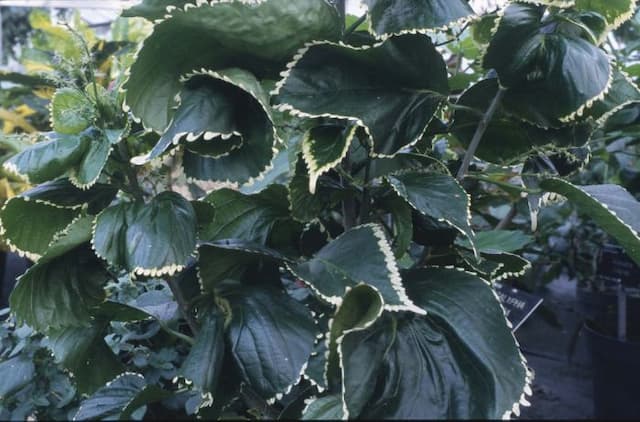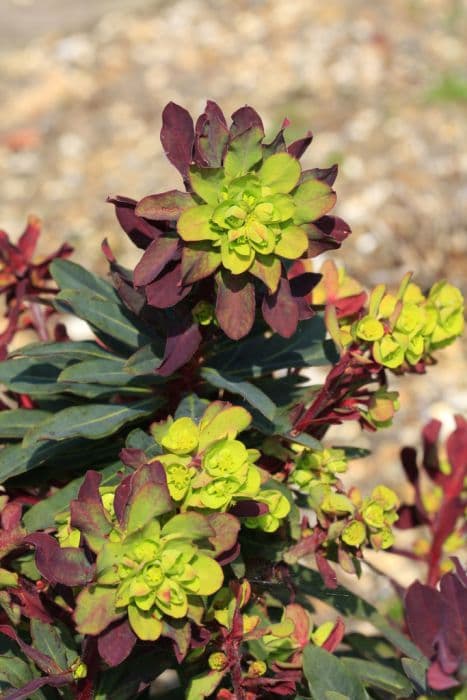Spurge Euphorbia × pasteurii

ABOUT
Euphorbia × pasteurii, commonly known as spurge, is a hybrid perennial plant with a distinctive appearance. This plant showcases a beautiful mounding habit with evergreen foliage that remains attractive throughout the year. The leaves of spurge are narrow, elongated, and arranged in a spiral fashion around the stems. They boast a rich, dark green color that can sometimes take on a reddish or purplish hue during the cooler months or in response to stress. Spurge is well-known for its striking flowers, which aren't true flowers in the traditional sense. Instead, what appears to be a single flower is a specialized structure called a cyathium, which contains several tiny male flowers and a single female flower. The cyathia are clustered together within cup-shaped bracts that are often a bright, eye-catching yellow-green or chartreuse color, creating a showy display that looks fantastic against the dark foliage. These bracts can sometimes be mistaken for petals because of their vivid coloration and prominence. The stems of spurge are sturdy, and the overall form of the plant is quite tidy and dense, which makes it an excellent choice for borders, rock gardens, or as a structural element in mixed plantings. It provides a strong visual impact with its contrasting foliage and floral structures. Despite its ornamental qualities, one should handle the plant carefully as it produces a milky sap that can be irritating to the skin and toxic if ingested. Overall, spurge adds a unique texture and color contrast to gardens and landscapes.
About this plant
 Names
NamesSynonyms
Spurge.
Common names
Euphorbia × pasteurii.
 Characteristics
CharacteristicsLife cycle
Perennials
Foliage type
Evergreen
Color of leaves
Green
Flower color
Yellow
Height
3 feet (0.91 meters)
Spread
3 feet (0.91 meters)
Plant type
Shrub
Hardiness zones
7
Native area
Hybrid
Benefits
 General Benefits
General Benefits- Ornamental appeal: Euphorbia × pasteurii, commonly known as Spurge, offers striking foliage and an attractive growth habit, enhancing garden aesthetics.
- Drought tolerance: Once established, Spurge is highly drought-resistant, requiring minimal watering, which makes it suitable for xeriscape gardens and water-efficient landscaping.
- Low maintenance: It requires little care in terms of pruning, feeding, or disease management, making it an ideal choice for low-maintenance gardens.
- Seasonal interest: The plant provides visual interest throughout the year and is particularly valued for its display of bright yellow-green flowers in spring and summer.
- Pest resistance: Spurge is known to be resistant to most pests, reducing the need for chemical interventions and making it an environmentally friendly garden choice.
- Adaptive to soil types: It can grow in a range of soil types, although it prefers well-drained soils, making it versatile for different garden conditions.
- Climate versatility: Spurge is capable of thriving in various climates, from temperate to subtropical zones, provided it has proper conditions.
- Attracts pollinators: Although not specifically cultivated for this purpose, its flowers can attract pollinators like bees, thus supporting local ecosystems.
- Fast growth: The plant establishes and grows quickly, allowing gardeners to achieve a mature look in their gardens relatively soon after planting.
- Suitable for mixed borders: Its size and form make it suitable for planting in mixed borders, where it provides contrast to other plants.
 Medical Properties
Medical PropertiesThis plant is not used for medical purposes.
 Air-purifying Qualities
Air-purifying QualitiesThis plant is not specifically known for air purifying qualities.
 Other Uses
Other Uses- Euphorbia × pasteurii can be used in mixed borders for its architectural form, providing a dramatic backdrop to other flowering plants with its upright structure.
- Its sap has been traditionally used as a fish stupefier in some cultures, where it is introduced into small ponds to temporarily immobilize fish for easy capture.
- The textured foliage and bracts of this plant can add a unique visual interest to cut flower arrangements, though care must be taken due to the irritant sap.
- As a natural barrier, the thorny and dense nature of Euphorbia × pasteurii can be used to deter animals and unauthorized entry into private properties.
- In crafts, dried stems of this plant may sometimes be used to create natural decorative elements or as part of the structural support in creations like wreaths.
- When planted in coastal gardens, Euphorbia × pasteurii can help stabilize the soil with its root system, preventing erosion with its hardy growth habit.
- Due to its tolerance to poor soils, it can be used in reclaimed or disturbed sites as part of re-vegetation efforts to help establish green cover quickly.
- In landscape photography and painting, the plant can serve as an intriguing subject or element in compositions due to its unusual shapes and bright green color.
- Euphorbia × pasteurii, when used in school gardens, can provide an educational example of hybrid vigor, demonstrating the concept of heterosis to students.
- In large public spaces or parks, this plant can be used to fill in areas where other plants struggle to thrive, providing greenery and interest with minimal maintenance.
Interesting Facts
 Feng Shui
Feng ShuiThe Euphorbia × pasteurii is not used in Feng Shui practice.
 Zodiac Sign Compitability
Zodiac Sign CompitabilityThe Euphorbia × pasteurii is not used in astrology practice.
 Plant Symbolism
Plant Symbolism- Resilience and Adaptability: The Euphorbia x pasteurii, commonly known as "Spurge," is a hybrid plant, which often symbolizes resilience and the ability to thrive in a variety of conditions, adapting to different environments.
- Protection: Spurge plants have a milky sap that can be irritating to the skin and toxic if ingested, which gives them a symbolic meaning of protection and defense against harm.
- Healing and Cleansing: Historically, some Euphorbia species were used for medicinal purposes. This lends the spurge a symbolism associated with healing and the cleansing of ailments or negative energies.
- Persistence: Given its vigorous growth habit, the spurge symbolizes persistence and the determination to overcome obstacles.
 Water
WaterEuphorbia × pasteurii, commonly known as Spurge, should be watered thoroughly, allowing the soil to dry out between waterings to prevent root rot. Typically, watering once a week during the growing season is sufficient. During the winter, reduce watering to every other week or less, depending on the humidity and temperature of your environment. It's essential to provide about one gallon of water to the soil around the plant, ensuring even moisture distribution without waterlogging the soil.
 Light
LightSpurge thrives best in full sun to partial shade environments. Ideally, it should receive at least six hours of sunlight daily, while being protected from the intense afternoon sun, especially in hotter climates. A spot that offers morning sunlight with dappled afternoon shade would be optimal for this plant.
 Temperature
TemperatureSpurge prefers temperatures between 50°F and 75°F and should not be subjected to temperatures below 30°F as it can cause damage to the plant. While it can tolerate a brief frost, prolonged exposure to cold will harm it. The ideal temperature range allows it to flourish and should be maintained as much as possible throughout the year.
 Pruning
PruningPruning Spurge is generally done to remove spent flowers, promote bushier growth, or maintain desired shape and size. It's best to prune in late winter or early spring, before new growth begins. Pruning can be carried out annually or as needed to remove any damaged or overgrown branches.
 Cleaning
CleaningAs needed
 Soil
SoilEuphorbia × pasteurii, commonly known as Spurge, thrives best in a well-draining soil mix with equal parts of loam, sand, and peat to ensure good drainage and aeration. Ideal soil pH for Spurge is between 6.0 to 7.5. A balanced slow-release fertilizer can be added to the mix for optimal growth.
 Repotting
RepottingEuphorbia × pasteurii, or Spurge, generally requires repotting every 2 to 3 years to replenish nutrients and to accommodate root growth. Choose a pot only slightly larger than the previous one to prevent waterlogging due to excess soil.
 Humidity & Misting
Humidity & MistingEuphorbia × pasteurii, known as Spurge, fares well in typical indoor humidity levels, which range from about 40% to 60%. The plant does not require high humidity and can tolerate drier air without adverse effects.
 Suitable locations
Suitable locationsIndoor
Place Spurge in bright, indirect light indoors.
Outdoor
Plant Spurge in full sun to part shade outdoors.
Hardiness zone
7-10 USDA
 Life cycle
Life cycleEuphorbia × pasteurii, commonly known as spurge, begins its life as a seed, which germinates in warm, moist soil where it forms a small root system and a shoot that emerges above the ground. As a seedling, it develops into a young plant with characteristic leaves and starts photosynthesizing to fuel its growth. Once mature, the spurge produces small, inconspicuous flowers typically encased within bracts, growing in clusters called cyathia, where pollination occurs and seeds are produced. After pollination, seeds develop and are eventually dispersed by various mechanisms, including wind or animals. The plant reaches maturity, often forming bushy clumps and continues to grow and spread, repeating the flowering and seeding cycle annually. At the end of its life span, which can vary in length but typically lasts several years, the plant will eventually senesce and die, leaving seeds to continue the species' lifecycle.
 Propogation
PropogationPropogation time
Spring to Summer
Propogation: Euphorbia × pasteurii, commonly known as Spurge, is primarily propagated through the division of its rootball. The best time to perform this propagation method is typically in the spring, just as the plant begins to show new growth. To propagate by division, carefully lift the entire plant from the ground, ensuring to retrieve as much of the root system as possible. Once out of the soil, use a sharp spade or knife to divide the rootball into sections, each with several growth points. Replant the divisions at the same depth they were originally growing, and water them thoroughly to help establish the new plants. It's crucial to handle all parts of the plant with caution and wear gloves, as the sap can be an irritant to the skin and eyes.



![Spurge [Blackbird]](/_next/image?url=https%3A%2F%2Fplants-admin.emdemapps.com%2Fimages%2Fplants%2F%2Fimages%2F604b535f37783.png&w=640&q=75)





